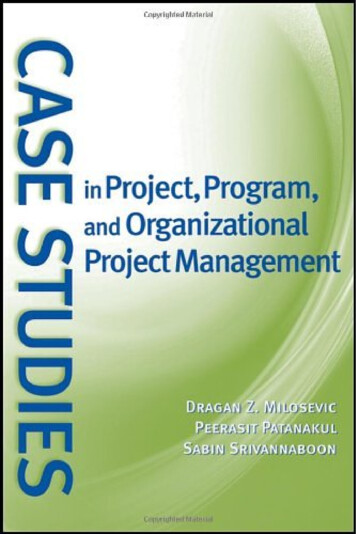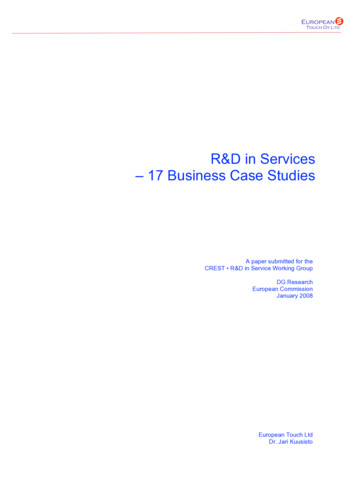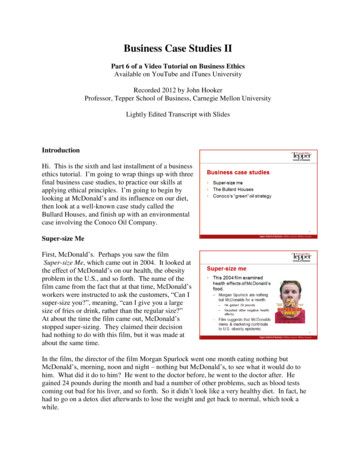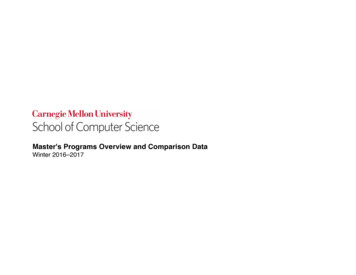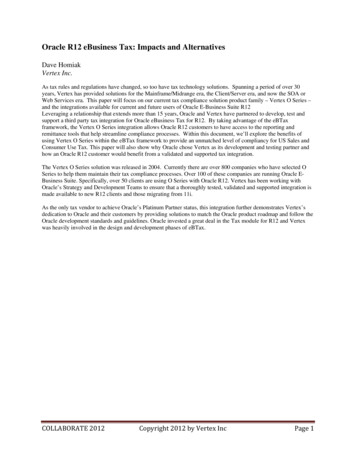
Transcription
eBusinessCase StudieseBusiness Case Studies IST-Africa Consortium 2005 - 2006
eBusiness – Case StudiesContentsEuropean eBusiness Case Studies. 31. Current Legal Issues for eBusiness . 32. eCommerce – Opportunities and Barriers in Poland. 63. Leveraging GRID Technology in Africa . 10Mozambiquan eBusiness Case Studies. 164. e-Business in the Banking Sector Case Study. 165. e-Business as an ISP Case Study . 20ii
eBusiness – Case StudiesEuropean eBusiness Case Studies1. Current Legal Issues for eBusinessLegislation to support the development and implementation of new Information andCommunication Technology (ICT) and reduce barriers to the adoption of eBusinessis an important indicator for economic success. While the EU’s legal and regulatoryframework in this regard has only been gradually developed over the last years, thereare valuable lessons learnt which can be leveraged in the implementation of alegislative environment to support the adoption of eBusiness in African States.Reflecting research carried out under the Legal-IST project, which was funded underthe European Commission IST Programme, this case study addresses four recentlystudied issues determined to be of high importance for eBusiness adoption inEurope. The objectives was to identify, address and study legal research areas todefine research and development needs for short, medium and long-term focus (withregard to technology, methods, organisational and human issues, businessrelationship and working groups, national legal entities and codes) as well as toinitiate and co-ordinate the analysis of specific issues of relevance for ICTbusinesses and to provide recommendations on each research area studied, suitablefor being used and adopted by policy-makers at EC level in order to evolve currentlegal framework. This research was based on questionnaire-based feedbackreceived from legal experts, SMEs, policy makers and NGOs across Europe.The four key legal issues for eBusiness in Europe identified are: Legal issues related to RFID Liability of information society service providers Self regulation on B2B internet trading platforms Business registry.1.1.1 RFIDRadio Frequency Identification (RFID) Technology uses radio waves to identifyobjects or people wearing RFID tags automatically and wirelessly. RFID has twoparts: a tag containing an identification number and reader that triggers the tag tobroadcast its identification number. RFID is of considerable interest in retail,consumer packaged goods and manufacturing supply chains in terms of potentialefficiency.Hospitals also plan to deploy RFID to identify patients, call up records, reducemedical errors and improve overall productivity. For instance, a pilot project hasstarted in July 2005 in the clinical centre of Saarbrücken in cooperation withcompanies such as Intel, Siemens Business Services and Fujitsu-Siemens. Thestudy also points out other fields of application including the use of RFID in passports(in November 2005 Germany introduced the first European e-passport, equipped withbiometric data stored on a RFID tag) and banknotes, use in libraries and even in thetracking of people (like for example in prisons).The key legal implications are related to RFID tags that directly store personal datasuch as name, age, nationality etc. The most prominent current legal issue is the onerelated with the protection of privacy and data protection. The study examines whichEuropean directives apply in relation to different categories of RFID tags, some ofwhich only include product reference numbers, while others can provide access to3
eBusiness – Case Studiespersonal data only in conjunction with a backend database. Issues related toobligations of the data controller are also considered.1.1.2 Liability of Information Society Service ProvidersThe background to this issue goes back to the adoption of the EU E-CommerceDirective, and whether there should be stronger protection for the fundamental rightsand freedoms of all internet users, or whether the directive should facilitate huntingdown individual internet users who broke the law by for example, sharing files andbreaching copyright in music. The original intention was facilitate the establishment ofInternet Service Providers (ISPs) as a business model and not hamper itsestablishment through liability risks.The study aims to provide a diagnosis of current liability problems as there is ageneral lack of regulation at the European Community level of a specific system ofliability. The study points out four fields of interest: The question of the liability ofproviders of Hyperlinks and Location Tools (where there is a general lack ofEuropean case law); liability for the provision of AdWords; claims for information; andproblems concerning injunctions.The main problems detected to date in relation to Hyperlinks and Location Tools arethat linking may give rise to a range of unlawful acts such as libel, intrusion ofprivacy, IPR infringements, trademark infringements, misleading advertising, unfaircompetition and breach of contract. A large number of the complaints are brought forpractical reasons: economic precariousness or lack of knowledge of the identity ofthe infringing party.In light of applicable legislation and available case law, the potential problemsconcerning Adwords (where suppliers pay a premium for their goods or services tobe highlighted if certain words are used in a search engine for example) are relatedto the legal definition of the concepts “keyword” and “metatag” and the legal nature ofthe “Adwords System”.The potential problems in relation to issue of claims for information are the lack ofharmonised legislation on the obligation for the ISP to retain traffic data and the lackof harmonised legislation related to claims for information.With regard to injunctions the study considers problems related to intellectualproperty infringements, and specifically some specific responsibilities of theintermediary.1.1.3 Self Regulation on B2B Internet Trading PlatformsWhile across Europe there is eCommerce related legislation at both a national andEuropean Directive level, self-regulation is still an important facet of Internetregulation. The development of codes of conduct is actually encouraged by theDirective on Electronic Commerce (2000/31/EC - Article 16). Legal issues related toself-regulation are analyzed from the perspective of legal validity and enforcement,including different types of self-regulation such as codes of practice / codes ofconduct, the use of trust marks and labelling, and best practice guidelines and theirlegal implications. There are valuable lessons to be learnt that can be considered foradoption in other jurisdictions outside Europe.Because of rapid technical developments and the trans-national nature of Internettrading platforms, self-regulation was proposed as a solution to increase the4
eBusiness – Case Studieswillingness of businesses to join a B2B trading platform. Part of the focus of thisstudy is to develop a template for such a voluntary code of conduct, identifying themain features of self-regulatory mechanisms and discussing the opportunity toaddress the identified barriers of entry on the B2B Internet trading platforms throughself-regulation rather than state intervention. It also outlines future research requiredinto how efficient a tool self-regulation can be for those considering joining a B2Btrading platform.1.1.4 Business RegistryAn electronic business registry (eBusiness registry) is a software system andinfrastructure that enhances information channelling and interactions, required byeBusiness. It enables organisations to store information, select business partnersand provide content for customers. However, information supplied by such a registrymay raise issues related to data protection and liability issues, depending on thequality and standards of its service.Using data warehousing techniques, allows analysis of data in a registry easy.However, depending on the methods used, information of varying quality can beproduced. The study on business registry gives a clear overview over what businessregistries are as well as of legal issues regarding this sector. It ends with a summaryof legislative recommendations.Barriers to eBusinessThe B2B Expert Group identified a series of factors that might explain the reluctanceof businesses (and especially SMEs) to fully engage in electronic trade. Theseinclude:o lack of awareness regarding the risks and benefits of joining a tradingplatform,o difficulties in identifying the most suitable platforms for them to join,o incompatibilities between technical standards,o insufficient information about the rules applicable to the marketplacetransactions,o financial barriers (costs of implementing a secured transaction protocol andmaintaining IT systems and websites).The study recommends:a. The formulation of Guidelines on the procedures to be followed in drafting a codeof conduct and in the involvement of relevant stakeholdersb. Studying the true effectiveness of the codes of conduct in modifying thebehaviour of market players, or marketplace operators. Such a research shouldinclude concrete examples of market changes brought by the implementation ofself regulatory measuresc. Carrying out legal research on the enforceability of the provisions of codes ofconduct by business partners or by third parties and available dispute resolutionmechanisms.d. Carrying out legal research regarding trustmarks, what rules govern their activityand the extent of their certification obligationsKey ConclusionsFor RFID, it is essential there is good coordination between technologists, regulators,legislators, and consumers to ensure that RFID can realize benefits to businessesand the wider society. Use of RFID requires serious consideration of data protection5
eBusiness – Case Studiesand data security implications, which in turn requires re-examination of the traditionallegal principles and instruments.For Liability of ISPs, it is essential to review the liability regime, taking into accountthe special role of ISPs in the Information Society. Greater legal certainty can beachieved by providing a legal definition of the appropriate court and out-of-courtaction and procedures.Technical rules for business registries should be standardized in order to protectprivacy of communication and to assure integrity and security of communications.Self-regulation including use of codes of conduct is essential for B2B TradingPlatforms. The creation of guidelines to help in the drafting of codes of conductswould be very beneficial. However, research into the enforceability of codes ofconduct is recommended.DiscussionAre similar legal issues currently being faced in your country or region?What relevance do you believe such legal related issues have for your region orcountry?What cultural, legislative or other barriers exist to successful adoption of eBusiness inyour country?ReferencesState-of-the-art of Legal Research in IST and the Way Forward,L. PULLMANN, T. BEHRENS, T. CHOWDHURY, University of Goettingen, GermanyExploiting the Knowledge Economy: Issues, Applications, Case StudiesPaul Cunningham and Miriam Cunningham (Eds)IOS Press, 2006 AmsterdamISBN: 1-58603-682-3More information is available at www.legal-ist.org2. eCommerce – Opportunities and Barriers in Poland2.1 IntroductionThe development of eCommerce is becoming a strategic factor for economicdevelopment for many countries. However, this requires regular monitoring andanalysis of trends, dynamism and changes of direction. Poland, which recently joinedthe European Union, is an interesting case in illustrating some of the opportunitiesand the main barriers to the development of eCommerce based on national research.While exploitation of available infrastructure to develop eCommerce is dependent onnecessary legislation and use of standards, the real impact is the appropriateness ofservices and applications used by the private sector and public administration tomeet local, regional and national societal requirements. This case study is based onthe results of national studies carried out by the Institute of Logistics andWarehousing, Central Statistical Office and Ministry of Science and InformationSociety Technologies and published in an annual report titled “Elektroniczna6
eBusiness – Case Studiesgospodarka w Polsce – Raport 2004”. The Institute works with the Ministry ofEconomy on the “Programme for 2003 – 2006 Creation of the mechanisms andstructures of the e-Commerce development in Poland”, which aims to improveeconomic competitiveness by adopting global e-Economy requirements.This research should provide valuable ideas for issues that developing economies inAfrica should consider in supporting wider adoption of eCommerce and eBusiness.2.2General Internet and eServices AdoptionRecent national initiatives and investment in infrastructure and education havestarted to have an impact in developing the information society in Poland. Internetaccess has increased by 10% since 2003 to 37%, with 2/3 of users under 35 years.While Poland is amongst the lowest ranking EU countries in this regard, the focus ofinitiatives has been on school children, and as such it will take time to see results.Only 26% of households in Poland have Internet access. One of the barriers to lowerInternet prices is the current de-facto monopoly of the one biggest Internet serviceprovider in Poland is a main barrier to decreasing the price of the Internet. Only fiveEU countries have lower level of access, i.e.: Greece, Latvia, Hungary, Lithuania andTurkey. There is also differences between rural access (15%) and access in citiesand towns (over 30%). This is mainly due to economic factors, with 80% of surveyparticipants noting high hardware and telecommunications costs as the main barriersto using the Internet.Despite this, the level of interest in Internet based services (eShops, services,eBanking) has doubled since 2003 and this trend seems certain to continue. Only17% of Internet users bought goods online, spending 360 million PLN (about 90million) annually. Main purchases were books, magazines, CDs, films, and educationmaterials. The main reasons for the low level of Internet transactions include (a) lackof confidence in the safety of transaction realization and related privacy concerns, (b)lack of confidence of customer service in the event of a problem and (c) problemsbuying online (37% of respondents reported problems). A major challenge thereforeis increasing public confidence in the security of online transactions, promoting theuse of credit cards (which in Poland is still low) and better quality eShop services.Only 14% of Polish Internet users use e-banking services, which is very lowcompared to EU leaders (Norway 73%, Finland 72%) according to Eurostat, andrepresent only 4% of those in the 16 – 74 year age group. However, this is expectedto dramatically increase due to investment by banks in developing and advertising ebanking services. 11% of survey respondents plan to use e-banking in the next 12months. There is lower interest in e-insurance services (4%), but this could be due toa lack of investment in the development of such services and lack of awareness as38% of respondents have bought an insurance policy during last 12 months (mainlythird-party and life insurance, but also property, household goods, travel and accidentinsurance. 63% of respondents were interested in life insurance. Despite thepotential for e-insurance services, most initiatives in this area are driven by banksrather than insurance companies themselves.2.3Business to Business (B2B) SectorThe B2B market in Poland has grown significantly for five years, with less than 39%of Small and Medium Sized Enterprises (SMEs) having Internet access in 1999, to85% by 2004. However, while at least half of SMEs have web pages, only a verysmall proportion offer online services. Almost 70% of companies now use Internetbanking and another 20% plan to use such services in the next twelve months. Most7
eBusiness – Case Studiesof the growth however, is from larger companies, with 17% ordering online and 4%paying online.In general, the percentage of Polish companies involved in the B2B market (13%) isclose to the European average of 14%. Major problems are international in nature lack of standardization of data exchange and too many standards. There is alsouncertainty in Poland in terms of the legal framework. The government“Programmefor 2003-2004” developed three main components of eCommerce platforms in 2004for SMEs: eCatalogue, electronic repository of eDocuments and offer system. Thegoal is to establsih a level playing field in Poland for SMEs.2.4Business to Consumer (B2C) SectorMany B2C focused companies went bankrupt in Poland initially. Today there are 600700 e-shops in Poland, most of which have relatively low turnover. According to eCard (which authorises most Internet transactions in Poland, in 2004 10 websitesaccounted for 90% of Internet turnover (Wakacje.pl, Travel-planet.pl, Polish TravelQua Vadis, Scan Holiday, Visit.pl, Bilety.pl, PLL LOT, Air-Polonia, Leclerc andMerlin.pl) (Source: E-handel: monopol dziesięciu, www.gazeta.pl, 13.10.2004).70% of owners of e-shops were also selling in a more traditional way. Only 30% of eshops had a mechanism for online payments, with 71% accepting bank transfers and93% payment on delivery. This is significantly different to the European average ((credit cards - 89%, payments on delivery - 58%, bank transfer – 56%). Returns andcomplaints are major logistical challenges for e-shops compared to normal shops,with 14% of eShops having 5-10% returns compared to an average of 1.5% innormal shops. The main problems were technical defects (79%) and packingmistakes (24%). Only 15% of B2C companies in Poland have complete back-endsystems, thus increasing costs, limiting potential orders.2.5eBankingPolish banks have been collecting eCommerce experiences for 7 years. In 2004 61%of traditional banks in Poland provided e-banking services. There were also 3Internet banks. e-Banking services were provided by six access channels: internetaccount (8%), electronic access to traditional account (63%), WAP (20%), phonebanking (58%), SMS (38%), TV (3%) and home-banking (73%). Most channels areavailable to both individual and corporate customers. Ideas for new products areusually based on traditional banking services adapted for new access channels.e-Banking is still in the process of development and banks have now stopped usingprice as the main factor to persuade clients to move to e-banking. Since 2004, thereare focusing on increasing the number of clients using such services, increasing thenumber of services offered and increasing the quality of such services. Polish banksare very positive about the opportunities and perceived benefits of rolling-out ebanking services to customers.2.6eAdministrationAccording to research carried out by the Polish Ministry of Science and InformationSociety Technologies. adaptation of IT in the Polish public sector accelerated in 2002– 2003. However, despite introducing new legal regulations, there was not an evendistribution of developments across the public sector. In October 2004 the PolishCustomers Services started a pilot use of electronic signatures in the “CustomsGateway’’ portal, which supports customs declarations, messages concerning transitin the framework of NCTS system, filling in INTRASTAT declarations and ElectronicData Interchange (EDI) with partners abroad. In 2004 the third edition of the ‘’Webbased survey on electronic public services” was carried out. Examination of 20 basic8
eBusiness – Case Studiespublic services, as defined by the European Commission, showed a considerableincrease in scores for the ‘’Income-generating service’’ cluster (increasing to 50%from 30% in 2003). This was mainly due to implementation of the ‘’Płatnik’’ (Payer)programme that allows clearing accounts within the Social Insurance Institution.‘’Registration’’ cluster services scored 38%, ‘’Permits and Licenses’’ cluster scored33% and "Returns’’ cluster scored 26%. However, the public services only achieveda 2% score on a new ‘’full service’’ scale (number of services providing the fullmaintenance of administrative processes). The survey of Internet related attitudes indifferent departments showed that many departments are not guided by the realrequirements of clients when planning and realising their activities, but rather whatthey need themselves. In this regard, local government seemed generally better atusing the Internet to contact citizens than national government. The launch of the‘’Gateway of Małopolska’’ and ‘’Gateway of Podlasie’’ should improve this situation inrelation to registrations, and obtaining documents and permissions. The developmentof the network of Public Internet Access Points (in 40% of Polish communes in 2004)will increase access to e-government.2.7Infrastructure, Technology and SafetyWhile the Polish IT market constitutes more than 34% of the market of 10 NewMember States, it is one of the less saturated with IT, with banks and financialinstitutions the main consumers of IT services. Research conducted by the PolishAgency for Enterprise Development indicated that the lack of computers was anessential barrier for SMEs, with only 47% having computers, usually one percompany. In 2004, 60% of companies used analogue modems to access theInternet. Surveys showed that the awareness about security threads was not veryhigh among SMEs, with most only protecting their data if a loss had already takenplace, typically due to hacking or viruses.In 2004 nearly all public administration offices had computers. 99,4% of departmentshad Internet access (48.9% analogue modem, 37.8% digital modem). About 20% ofdepartments had IT systems for handling public orders. As a result, 87% ofdepartments did not use authorization tools. Antivirus protection was common indepartments but only 59% used firewalls to protect the security of personal andbusiness data.By comparison banks were quite advanced, with all having Internet access usingwide band or wireless connections by 2004. Moreover, all of them had their ownintranet systems. Most workers had access to IT infrastructure and to the Internet. Allbanks apply SSL coding protocol for the safety of transmission of data. Antivirusprotection, firewalls and cryptography were also commonly applied. Although allinstitutions worked with advanced information technologies and collected personaldata, only 25% admitted the actual or potential occurrence of security violations,mainly viruses. Institutions used 6 types of security. Most used anti-virus softwareand firewalls, with back-up coies of data stored off-site. 69% used digital signaturesas an authorisation tool, with codes, passwords and use of encryption to assureconfidentiality of data. Almost all regularly update security tools.2.8ConclusionsComparing to most other European countries Poland still has a lot to do to supporteCommerce and eBusiness, and e-services provided to citizens by publicadministration.That having been said there continues to be a dramatic increase in the numbersenjoying Internet access (2000 – 19%, 2004 – 33%), with 61% of users using the9
eBusiness – Case StudiesInternet every day or almost every day. The main challenge is relatively high Internetrelated costs. There is considerable economic potential in developing both the B2Band B2C sectors, as well as eGovernment related services to citizens. It is clear thatgovernment initiatives are making progress in supporting the development of B2Bmarkets. Implementation of the EANIC e-catalogue for SMEs, creates a commonlanguage and helps to support data exchange between SMEs and should help drivedown operating costs. While the B2C sector shows economic promise, 90% ofcurrent turnover is accounted for by the ten largest e-shops and in general, turnoverin such e-shops is low. A key requirement for economic development however, is thedevelopment of back-office functionality.While almost all Polish banks provide e-banking services for private individuals andcompanies, the public sector lags behind, with most services of mainly an informationrather than interactive character. The government has much to do in this regard.2.9DiscussionAre similar issues currently being faced in your country or region?What relevance do you believe such issues have for your region or country,particularly in relation to services to citizens and business by public administration?What kind of gaps exist between e-services provided by national and regional or localgovernment?What cultural, legislative or other barriers exist to successful adoption of eBankingand eBusiness in your country?ReferenceseCommerce in Poland – State-of-the-art, Opportunities and BarriersM. KRASKA, Institute of Logistics and Warehousing, Poznań, PolandInnovation and the Knowledge Economy: Issues, Applications, Case StudiesPaul Cunningham and Miriam Cunningham (Eds)IOS Press, 2005 AmsterdamISBN: 1-58603-563-03. Leveraging GRID Technology in Africa3.1IntroductionGrid computing is a recently developed technology for distributed storage andprocessing of data, providing virtualised access to large scale computing resourcesfor a variety of scientific and commercial applications. Europe is pioneering Griddevelopment and deployment, and its applications in science, commerce and societyin general. The work described in this case study is co-funded by the EuropeanCommission under FP6 though the EGEE project, contract number 508833. Thiscase study presents current Grid work in Europe, and lessons & recommendationsfor the development of Grid computing in Africa.As well as the need for raw computing power, storage and processing of very largeand complex data sets, the Grid offers a number of other distinct advantages. Itallows interest groups (at present mainly scientific communities) to collaborate in asecure environment, passing on and analysing shared data. Biomedical applicationsinclude drug discovery for malaria to protein sequence analysis. All the communitiesusing the Grid also benefit from the remote access offered by Grid infrastructures. Asscientific communities become more specialised, groups working on the sameproblems tend to become more dispersed. Already the Internet has had a massive10
eBusiness – Case Studieseffect on these communities, making sharing of small electronic data sets a simpledaily task. The Grid allows dispersed communities to share processing as well asstorage resources, providing a virtual collaboration platform where all users can haveequal access to the combined resources of the whole community.Non-scientific use of Grid computing is of particular interest to the developing world,as it has scope to ease aspects of the digital divide through location-independentaccess to world class, large-scale computing resources. However, adopting Gridrequires significant investment in the fabric underlying a workable Grid infrastructure,and reaching agreements with collaborators is time consuming process. This is onereason why Africa can benefit enormously from leveraging efforts from Europe.Parts of the Mediterranean coast of Africa became connected to the pan-EuropeanGÉANT2 network infrastructure from December 2001 through the EuropeanCommission (EC) funded EUMedConnect project (www.eumedconnect.net), and theEC recently funded the EUMedGrid2 project. This will connect the nascent EuropeanGrid Infrastructure, pioneered by the Enabling Grids for E-sciencE (EGEE) project, toEgypt, Tunisia, Algeria and Morocco during 2006. Despite these beginnings, thereare still many unexplored opportunities for Africa to learn from the European Gridexperience.EGEE is the flagship Grid Infrastructure project of FP6 and the largest multi-scienceGrid in the world. Launched in 2004, EGEE following on from the successfulDataGrid (EDG) project (http://eu-datagrid.web.cern.ch/eu-datagrid/). Its goal is tocombine existing regional and thematic European Grid initiatives into a productionquality infrastructure. After testing Grid in projects such as EDG and DataTAG(http://datatag.web.cern.ch/datatag/) under FP5, EGEE was the first Europeanattempt to build the end product of Grid technology: a functioning, distributed, wellprovisioned, user orientated Grid infrastructure. EGEE began with about 70contracting partners and six distinct user communities.The EGEE infrastructure is of interest to Africa not only as its nearest major Gridinfrastructure, but also because its connections to the continent through theEUMedConnect and EUMedGrid projects. These links open the way for organicgrowth into Africa with low economic and organisational barriers and quickest Returnon Investment (ROI).3.2Considering Grid from Different Points of ViewGrid can be considered from three perspectives: what the user sees; how the grouprelates to their Virtual Organisation (a group of users sharing requirements,resources and in some cases, datasets); and how the user’s job is processed on theinfrastructure.The user goes to a website, logs on (by providing some proof of identity) and submitsa job for processing. After processing, the user receives the results through the sameinterface.Each user is also part of a group of users (Virtual Organisation - VO). From thisperspective, any authorised user can log onto a Grid website, and by doing so isconnected with the VO of which they ar
eBusiness – Case Studies European eBusiness Case Studies 1. Current Legal Issues for eBusiness Legislation to support the development and implementation of new Information and Communication Technology (ICT) and reduce barriers to the adoption of eBusiness is an important indicator


